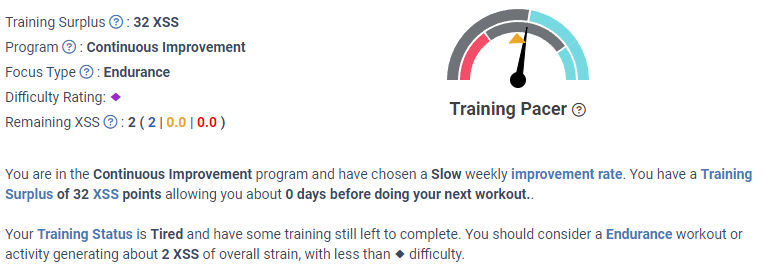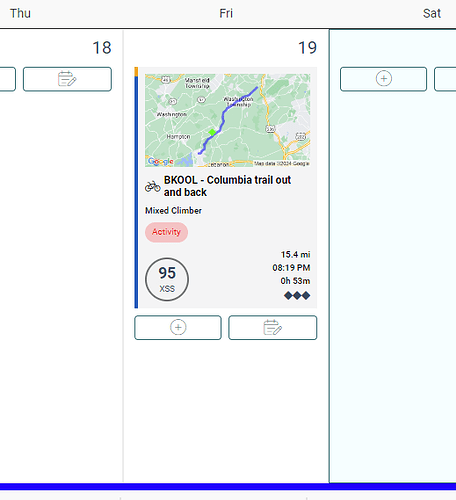Strange. It looks like your fitness signature for 28th changed? Different focus and different XSS?
Well, the summary line takes into account the workout on 12/30, so that’s probably why numbers changed, I would also expect only future training status to change, but here it seems to have backdated things.
Sudden XSS swings is explained in the FAQ Improve section.
The change in the freshness form gradient (past, present, or future) is what you would expect by adjusting the Recovery Demands slider to the right. I.e. more red or yellow after a higher intensity workout.
As you noted Xert’s HRDM (HR derived metrics) can closely estimate strain metrics for cyclists who have sufficient historical data with HR, power, and cadence. Preferably data from the bike you ride the most.
Xert may not be a great fit for you. Power is king. HR is certainly useful but secondary.
One you start riding outdoors try enabling HRDM and see how well it works for rides without power but with HR and preferably cadence captured.
If you decide not to stick with Xert, good luck with whatever you find works best for you.
That FAQ just confirms what I was saying - XATA seems to be using pre-defined approximation based on moving average and is strongly impacted by irregularities in training. This will work for someone, who sticks to regular schedule and prescribed workouts, but once you deviate (ex. do long outdoor ride one week and then short and intense workouts same day next week) that approximation breaks.
And no, I do not think I moved Recovery Demands slider between these two screenshots. And if I had moved it, it would be just one notch and I would have seen this change right away - there wasn’t any, the recalculation happened next day and changed historical data - and that’s why I have a problem with this… Whatever XATA calculated yesterday, should be displayed as is, never backtracked - even that algorithm now thinks values should have been different. There is no time machine - whatever happened - happened and should stay. It can be marked though to show that new approximation changed from whatever it was predicting two days ago.
HR based metrics - yes, I really hope that Xert does use historical HR data to better estimate TL without power meter. With good history of in-door rides on the trainer, it should be able to get good estimates for outdoor rides… I do not want to go and check this, but the point is not just about derived metrics, but presenting HR based analytics - as I have mentioned - recovery time, decoupling and trends. Having a good workout to estimate LTHR would be great as well, etc. Very sad that Xert collects HR data but does not really present any analytics of it ![]()
Time will tell if it meets my need. Overall, it provides good power analysis - I like it, but without other sports and HR data - it is much less useful for me.
I have entire summer of outdoor rides with HR in Xert. I can look at estimated XSS for them - and that’s really it. With just two HR parameters in settings - resting and max HR - and not taking into an account LTHR which many other platforms use - I have my doubts on the resulting accuracy…
I have a question - @ridgerider2 may be you can help here - are there any scientific publications which Xert/XATA is basing its algorythms? If so, can you please point me to some of them? Are these algorithms trademarked/patented/open?
Would like to learn a bit more from the base science (Xert documentation gives me a lot of headache being spread across so many pages with several repeating articles…)
I doubt xert is going to share algorithms, given these are their strong USP. I also doubt that would be useful for lot of people, copy cats apart.
I think it’s based on a number of well adjusted models around physiology and established training principles.
Some main pillars probably are
- the three muscular energy systems, reflected in the low/high/peak xss model.
- The MPA model, which predicts fatigue and recovery for efforts above threshold. There is probably no “science” around that as it’s the core invention of xert while everyone else deals with the way less useful W’ etc. But well, put the number on the screen and pedal hard until you can’t. You will soon see that it works (or get a breakthrough)

- The freshness model, which probably is not too far from the likes which were established by trainingpeaks back then.
- training load (aka “more is more”), which is well backed up by science and practical experience
- specificity/ “focus” in xert lingo (aka. “train like you want to race”), same
- periodization. Everyone backs up his prefered model with his favoured 8 person 12 week trial study. So thats what we have.
- fitness signature, which probably is more or less derived from the critical power curve/model, which is well backed up
- a lot of modeling math in the head of the designers
I’d not prematurely give up on the documentation, as it hides some true gems. E.g.
or
@Beutelfuchs Thankyou for the information. I don’t agree that algorithm would not be useful… Or, to clarify, not an algorithm by itself, rather the underlying science theory - which should be publishable in reputable journal, at least…
I am far from an expert in the physiology or training, but I have read a number of articles in the field and almost all of them include cardiovascular system as part of the variables playing important role in sports training and that’s what really surprises me - Xert manages to almost completely avoid that…
But anyway - back to the algorithm’s recommendations - it continues to give me very strange advice!
Right at this moment it tells me that I have to take training of 2 (two!) XSS (and I have to take it event that I still have a surplus) and my status is tired/amber:
But Planner insists that my status is fresh/blue!!
Who do I believe? ![]()
![]()
In my opinion, Xert team is too focused on making Forecast AI provide some believable advice to the point that the “legacy” algorithm is broke now - I feel that it was working better before…
Not sure I follow. What is xert avoiding exactly?
Yes, the UI has still some quirks which can be confusing if you are new.
Could that be better? Yes.
But let’s see things in perspective. There are tools with polished UIs, which don’t show you whats going on under the hood. If there is much going one.
A fair comparison to xert would be Golden Cheetah, Wko or such. See if you find these more straight forward ![]()
You’ve already trained today (and you have a surplus), so not sure why the 2 XSS is confusing. The pacer is right on track near the 12 o’clock position, so why not just leave it for tomorrow? The system will always recommend some training, even after you’ve already uploaded a ride for a day.
We’ve left the original XATA more or less unchanged - I can’t recall any changes that have been made to it in some time now. We know many people still enjoy using it and may not be interested in the ForecastAI beta at the moment.
There is no HR analysis - no way to see and monitor efficiency factor or decoupling.
No way to adjust HR zones.
No tracking of HR recovery time.
@ManofSteele 2 HSS is not confusing, it is just laughable - system should be smart enough to handle this better - only recommend some workout volume which is not less than 20 min otherwise carry it over to next day automatically. Apparently, Xert can’t do this simple analysis?
And this is one of the things I do not agree with - if training was already done, Xert should not recommend training, it should recommend rest!
What might be confusing - is discrepancy in the training status in Training tab vs Planner. But again, this is probably a bug which results in quick swings in training status as shown in Planner and backdating of recalculations and I have shown previously.
I can handle Xert recommendations - I learnt to “translate” them to something sane… But the question is - if I have to do all the work on interpreting wired recommendations - I can do so with any other platform which can display progression chart… My hope was that Xert would let me avoid doing my own analysis so I can just follow recommendations.
I don’t find that surprising, as since the advent of powermeters, HR doesn’t play a significant role any more to steer things. And xert emerged primarily as a cycling platform.
I know they now also support running, but since I never checked it out I don’t know if there is any HR taken into account there.
I don’t believe it is that easy. Let’s say you have commuted and gained 20 XSS or so. Xert should still recommend training.
I do however agree with you that there should be a cutoff. If you have only have 15-20 XSS remaining, Xert could recommend rest or a slightly longer workout. It should be noted that this cutoff is probably individual and dependent on the training volume.
People like Joe Friel wouldn’t agree with you, you can check what he has to say about this here. I am not an expert, but Joe is a well-know name with well-known books and research. If Xert would publish its own research showing that HR does not matter - I’d definitely be interested to read…
Yes, absolutely. I do not remember where I read that for most training to be at least somewhat effective, it should last at least 20 minutes. This is somewhere in the ball park of 15 XSS for recovery session, so I would expect Xert to not recommend anything less than that.

